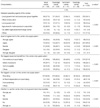Abstract
The purpose of this study was to investigate school dietitians' satisfaction with and needs for School Meal Service Support Centers. A web-based on-line survey was conducted with 1,102 nutrition teachers or school dietitians using four School Meal Service Support Centers during the summer of 2011. The data from 578 respondents (52.5%), consisting of 165 (44.4%), 334 (53.4%), 41 (67.2%), and 38 (86.4%) dietitians using Seoul, Gyeonggi, Suncheon and Gyeongju centers, respectively, were analyzed. The main reason for using the centers was subsidies from local governments. The dietitians using the metropolitan centers, which were Seoul and Gyeonggi centers, tended to buy agricultural products through the centers only, and those using local centers, which were Suncehon and Gyeongju centers, bought those products from the private suppliers as well as from the centers. The dietitians' overall level of satisfaction with the centers was not high showing 3.3 out of 5 points; it was significantly associated with the operating system and services of the centers such as system efficiency, delivery accuracy, communication, and information provision rather than the agricultural products provided by the centers. The dietitians preferred joint operation of the centers by local governments and producers' groups. They wanted School Meal Service Support Centers to be evaluated every year. It was suggested that efforts should be made to improve the operation system and service of School Meal Service Support Centers for improving dietitians' satisfaction with the centers. In addition, an evaluation system for School Meal Service Support Centers should be implemented soon based on school dietitians' needs.
Figures and Tables
Table 3
Dietitians' use of School Meal Service Support Centers

1) By chi-square test
2) Including "Publicness of the center due to supervision of local governments" 38 (6.6%), "Contribution to local agricultural development & environmental preservation" 20 (3.5%), "High quality of agricultural products" 18 (3.1%), etc.
3) Including 8 (21.1%) dietitians having responded "Contribution to local agricultural development & environmental preservation"
References
1. Chae SH. A study on the current status and development method for school meal service support centers. Nonghyup Economic Research Institute. 2010. cited 2012 April 6. Available from http://library.mest.go.kr.
2. Choi HY. A study on the current use and satisfaction in environmentally-friendly farm products in school feeding for secondary and high schools in Gwangju. 2008. Chosun University;86–91. MS thesis.
3. Gyeonggi Province. The action plans of supply of environmentally friendly agricultural products for shool food service 2011. Internal report of Agricultural Product & Distribution Division. 2011.
4. Gyongsangbuk-do Gyeongju Office of Education. The action plans of supply of excellent food materials for school food service 2011. Internal report of Gyeongju Office of Education. 2011.
5. Hwang JS. A survey on use of environment-friendly agricultural products for school food service by nutritionists in Kyeonggi province. 2010. Chung-Ang University;65–67. MS thesis.
6. Japan Speciality Agriculture Products Association. Chisan chisyo network of Japan. 2010. cited 2011 July 28. Available from http://www.jsapa.or.jp/chisan/chisan.html.
7. Jeollanam-do. A study on the development of supply model of environmentally friendly agricultural products for school food service. 2005.
8. Jung HJ. Food purchasing status and dietitian's perception on standard menu and foodservice support center for school food service in Changwon-si. 2010. Kyungnam University;63–69. MS thesis.
9. Kwon SK. A review on validity of establishment of school meal service support centers in Siheung city and acting plans. 2010. Dongguk University Industry Academy Coorperation Foundation;(Research report for Sihueng city).
10. Kwon YK. A study on evaluation of demonstration project of local produce supply and improvement strategy for school food service. 2006. Korean Institute for the Study of Rural Societies;(Research report for Nonghyup).
11. Excellent case study reports on school food service. Ministry of Education, Science and Technology. 2011. cited 2012 January 5. Available from http://library.mest.go.kr.
12. School meals act. Ministry of Government Legislation. 2007. cited 2011 August 11. Available from http://www.moleg.go.kr.
13. Park YB. A study on development of SCM of local products for shool food service. Research report of ministry for food, Agriculture, Forestry and Fisheries, Region & Agriculture Network. 2010.
14. Seo JY. Increasing consumption of environmental friendly agricultural products: The focus on school lunch program. 2006. Chonnam National University;113–115. Dissertation.
15. Seong JK. A study on revitalization plan for distribution of environmentally friendly agricultural products, The Agro-food New Marketing Institute. 2008. (Research report for Seoul Agricultural & Marine Products Corp.).
16. Seoul Metropolitan Office of Education. . The basic plans for school food service 2011. 2011. cited 2011 July 5. Available from http://www.sen.go.kr>administration information>policy materials.
17. SPSS Inc. PASW Statistics 18.0. 2009. [Predictive analytics software].
18. Suncheon-si. The supply plans of food materials for school food service 2011. Internal report of Agricultural Policy Division. 2011.
19. United States Department of Agriculture. Farm to school. 2011. cited 2011 October 7. Available from >SchoolMeals>Farm to School.
20. Yang IS. Development and support strategies of the food supply system in school food service. 2003. Yonsei University;(Research report for the Ministry of Agriculture and Forestry).




 PDF
PDF ePub
ePub Citation
Citation Print
Print








 XML Download
XML Download